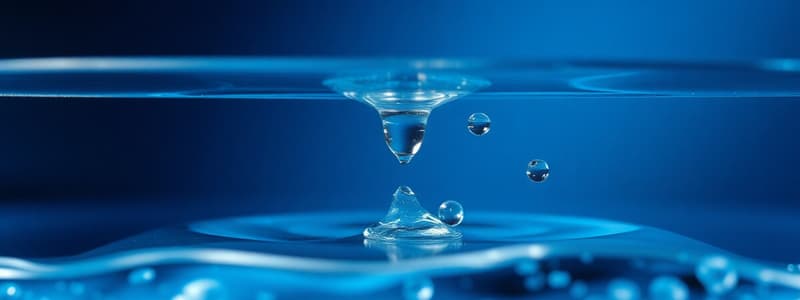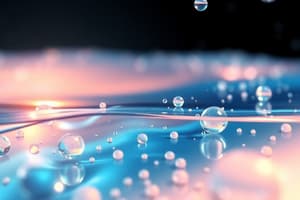Podcast
Questions and Answers
What unit is used to measure surface tension?
What unit is used to measure surface tension?
- kg m-1 s-2
- N m-1 (correct)
- J m-2
- Pa
What effect do soaps and detergents have on surface tension?
What effect do soaps and detergents have on surface tension?
- They have no effect on surface tension.
- They reduce surface tension. (correct)
- They eliminate surface tension completely.
- They increase surface tension significantly.
How does the surface tension of water change with temperature?
How does the surface tension of water change with temperature?
- It remains constant.
- It varies randomly.
- It increases significantly.
- It decreases significantly. (correct)
Which of the following has the highest surface tension at 25°C?
Which of the following has the highest surface tension at 25°C?
What is the typical lifetime of a molecule at the surface?
What is the typical lifetime of a molecule at the surface?
How do impurities affect surface tension?
How do impurities affect surface tension?
What does surface free energy represent?
What does surface free energy represent?
At what temperature is water's surface tension listed as 72 mN m-1?
At what temperature is water's surface tension listed as 72 mN m-1?
Which of the following is true about the relationship between surface tension and surface free energy?
Which of the following is true about the relationship between surface tension and surface free energy?
Which characteristic describes hydrophobic substances at the liquid interface?
Which characteristic describes hydrophobic substances at the liquid interface?
What role do surfactants play in the formation of stable emulsions?
What role do surfactants play in the formation of stable emulsions?
Which of the following surfactants is water soluble?
Which of the following surfactants is water soluble?
What happens when a temporary emulsion is left undisturbed?
What happens when a temporary emulsion is left undisturbed?
What is the effect of reducing interfacial tension in an emulsion?
What is the effect of reducing interfacial tension in an emulsion?
Why is the formation of a mixed monolayer important in emulsions?
Why is the formation of a mixed monolayer important in emulsions?
What term is used to describe the transition region where two immiscible phases come into contact?
What term is used to describe the transition region where two immiscible phases come into contact?
What happens to surface molecules compared to those in the bulk of a liquid?
What happens to surface molecules compared to those in the bulk of a liquid?
What is the phenomenon called when one phase is liquid and the other is gaseous?
What is the phenomenon called when one phase is liquid and the other is gaseous?
Which of the following accurately describes what interfacial tension refers to?
Which of the following accurately describes what interfacial tension refers to?
Which of the following pairs represents a solid-gas interface?
Which of the following pairs represents a solid-gas interface?
What is meant by the term 'surface free energy'?
What is meant by the term 'surface free energy'?
Which characteristic is true regarding the surface molecules of a liquid?
Which characteristic is true regarding the surface molecules of a liquid?
In a surface tension scenario, what phase is typically interacting with a liquid phase?
In a surface tension scenario, what phase is typically interacting with a liquid phase?
What occurs to reduce the energy in water droplets?
What occurs to reduce the energy in water droplets?
What is a consequence of increasing the surface area of a solid?
What is a consequence of increasing the surface area of a solid?
What is the primary reason for the spherical shape of water droplets?
What is the primary reason for the spherical shape of water droplets?
What happens to surface molecules in relation to their bulk counterparts?
What happens to surface molecules in relation to their bulk counterparts?
In terms of dynamic equilibrium, what occurs when surface molecules leave the surface and enter the bulk?
In terms of dynamic equilibrium, what occurs when surface molecules leave the surface and enter the bulk?
Why must energy be supplied when increasing the surface area of a solid or liquid?
Why must energy be supplied when increasing the surface area of a solid or liquid?
What best describes surface tension in relation to the surface molecules of water?
What best describes surface tension in relation to the surface molecules of water?
Which of the following statements about surface free energy is true?
Which of the following statements about surface free energy is true?
What role do surfactants play in preventing coalescence?
What role do surfactants play in preventing coalescence?
How does ionization state affect the partition coefficient of a drug?
How does ionization state affect the partition coefficient of a drug?
Which of the following statements about surfactants is NOT true?
Which of the following statements about surfactants is NOT true?
Which factor is crucial for a drug's ability to permeate the gastrointestinal tract?
Which factor is crucial for a drug's ability to permeate the gastrointestinal tract?
What is the main difference between drug solubility and dissolution?
What is the main difference between drug solubility and dissolution?
Which of the following examples represents a surface-active drug?
Which of the following examples represents a surface-active drug?
What is an essential characteristic of excipients in pharmaceutical preparations?
What is an essential characteristic of excipients in pharmaceutical preparations?
Which of the following is a common natural source of surfactants?
Which of the following is a common natural source of surfactants?
Flashcards
Surface tension
Surface tension
The force that holds the surface molecules of a liquid together. It acts like a thin skin that prevents the liquid from spreading easily.
Surfactants
Surfactants
Substances that reduce the surface tension of a liquid.
Hydrophilic
Hydrophilic
A material that has a strong attraction to water molecules.
Hydrophobic
Hydrophobic
Signup and view all the flashcards
Wetting
Wetting
Signup and view all the flashcards
Interface
Interface
Signup and view all the flashcards
Interfacial tension
Interfacial tension
Signup and view all the flashcards
Surface free energy
Surface free energy
Signup and view all the flashcards
Emulsion
Emulsion
Signup and view all the flashcards
Suspension
Suspension
Signup and view all the flashcards
Dispersion
Dispersion
Signup and view all the flashcards
Equivalence of Surface Tension and Free Energy
Equivalence of Surface Tension and Free Energy
Signup and view all the flashcards
Surface tension of water and temperature
Surface tension of water and temperature
Signup and view all the flashcards
Wetting ability and surface tension
Wetting ability and surface tension
Signup and view all the flashcards
Emulsification
Emulsification
Signup and view all the flashcards
Minimization of Surface Area
Minimization of Surface Area
Signup and view all the flashcards
Milling
Milling
Signup and view all the flashcards
Minimum Total Free Energy
Minimum Total Free Energy
Signup and view all the flashcards
Emulsion Formation
Emulsion Formation
Signup and view all the flashcards
Dynamic Equilibrium for Surface Molecules
Dynamic Equilibrium for Surface Molecules
Signup and view all the flashcards
Surface Molecules Have a Net Inward Pull
Surface Molecules Have a Net Inward Pull
Signup and view all the flashcards
Water Surface Exhibits a 'Skin'
Water Surface Exhibits a 'Skin'
Signup and view all the flashcards
Amphiphilic/Amphipathic
Amphiphilic/Amphipathic
Signup and view all the flashcards
Solubility
Solubility
Signup and view all the flashcards
Dissolution
Dissolution
Signup and view all the flashcards
Partitioning
Partitioning
Signup and view all the flashcards
Partition Coefficient
Partition Coefficient
Signup and view all the flashcards
Permeation
Permeation
Signup and view all the flashcards
Surface-Active Drugs/Excipients
Surface-Active Drugs/Excipients
Signup and view all the flashcards
Study Notes
MPharm Programme - Surface Tension & Surfactants
- Interface: A transition region where two immiscible phases meet. Examples include liquid-vapor (liquid surface in air), liquid-liquid (emulsions), solid-liquid (suspensions), solid-vapor (solid surface in air), and solid-solid (solid mixtures).
- Surface Tension: The force acting parallel to the surface, at right angles to a 1m line anywhere on the surface. Measured in N m⁻¹. Water's surface tension at 25°C is 72 mN m⁻¹.
- Surface Tension Decreases with Temperature: Hotter water is a better cleaning agent because its lower surface tension allows it to penetrate pores more effectively.
- Surface Tension and Temperature Correlation: The relationship is approximately linear.
- Surface Free Energy: Excess energy at the surface compared to the bulk. The work needed to increase surface area isothermally and reversibly by 1 m². Numerically equivalent to surface tension.
- Surface Molecules: Have higher energy and experience an inward pull, leaving the surface and entering the bulk in dynamic equilibrium. Typical lifetime is 1 microsecond.
- Wetting Phenomena: A solid's interaction with a liquid (e.g., float on surface or sink). Hydrophobic interactions (no affinity for water) cause floating; hydrophilic (affinity for water) causes sinking.
- Contact Angle: The angle between the tangent to the liquid surface and the solid surface at the point of contact. Measures the wettability. Zero degrees is absolute wetting; 90 degrees is partial wetting; above 90 degrees is no wetting.
- Measurement of Surface Tension: Methods include Wilhelmy plate and du Nouy tensiometer.
- Wilhelmy Plate: Thin rectangular plate (glass or mica) attached to a torsion balance; dipped into the liquid under investigation. Force is calculated to detach the plate; this is used for measurements.
- du Nouy Tensiometer (Ring Method): Measuring the force needed to detach a platinum ring from the surface/interface. Detachment force = surface tension * perimeter. Ring radii (inner and outer) are needed for calculations.
- Surfactants: Substances with both water-loving (hydrophilic) and oil-loving (hydrophobic) structural components in a single molecule. Amphipathic. Hydrophobic groups (typically hydrocarbon chains) have no affinity for water. Hydrophilic group(s) have affinity for water.
- Surfactant Action: Orients at the surface/interface, with the hydrophobic portion away from water. This reduces surface tension and interfacial tension. They can act as barriers to coalescence (for example, droplets in liquid emulsions). Examples of surfactants include sodium dodecyl sulfate and cetostearyl alcohol.
- Emulsions: Colloidal systems of two or more immiscible liquids. Examples include oil-in-water (o/w) and water-in-oil (w/o) emulsions. Surfactants are crucial for stabilizing emulsions.
- Traube's Rule: For dilute solutions of a homologous series of aliphatic alcohols, the ratio of the concentration at the surface layer to that in the bulk increases by a factor of approximately 3 for each additional -CH2 group.
Studying That Suits You
Use AI to generate personalized quizzes and flashcards to suit your learning preferences.





